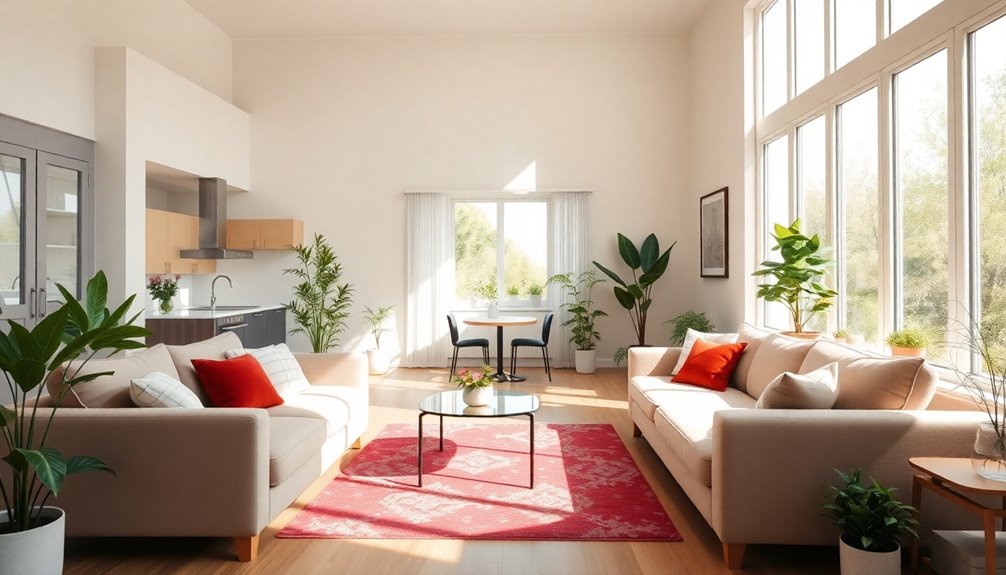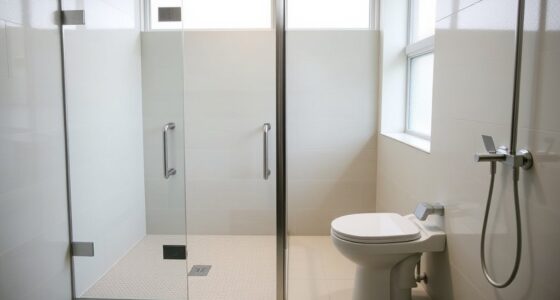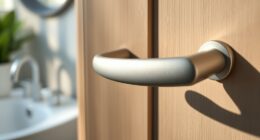Revitalizing your home with age-friendly design ideas is essential for safety and comfort. Start by applying universal design principles; create accessible entryways, add ramps, and install non-slip surfaces. Enhance mobility by widening doorways, using lever-style handles, and incorporating open layouts. Don't forget to improve bathroom and kitchen safety with grab bars and slip-resistant flooring. Consider smart home features for convenience and security. Stay tuned for more tips to transform your living space into a haven for all ages!
Key Takeaways
- Implement universal design principles to create a home that accommodates all ages and abilities, enhancing safety and comfort.
- Upgrade entryways with ramps, non-slip surfaces, and motion-sensor lighting for improved accessibility and visibility.
- Enhance kitchen safety by utilizing pull-out shelves, lever-style faucets, and slip-resistant flooring to reduce fall risks.
- Design elder-friendly staircases with sturdy handrails, bright lighting, and color contrast to ensure safe navigation.
- Integrate smart home features for emergency preparedness, offering remote access, voice control, and increased security to support aging in place.
Understanding the Principles of Universal Design for Home Modifications

When you think about making your home more accessible, understanding the principles of Universal Design (UD) is essential.
These universal design principles focus on creating spaces usable by everyone, regardless of age or ability. Key elements include equitable use, flexibility in use, and simple, intuitive design that requires minimal physical effort.
By prioritizing clear, perceptible information and allowing for error tolerance, you can guarantee your home is functional and safe, particularly for elderly residents.
Implementing these principles in your home modifications not only enhances safety and accessibility but also promotes independence and comfort.
Plus, homes designed with UD features, like no-step entries and wide doorways, can boost property value and appeal in the housing market. Additionally, integrating home security systems can further ensure the safety of all residents, particularly the elderly.
Creating Safe and Accessible Entryways for the Elderly

Creating safe and accessible entryways is essential for elderly residents, as it greatly impacts their mobility and comfort at home.
Start by ensuring your entryway is well-lit, which enhances visibility and considerably reduces the risk of falls. Clear pathways free from obstacles and non-slip surfaces make maneuvering easier and safer.
Install convenient landing spots for keys and packages to minimize fumbling, boosting overall accessibility. If you're accommodating mobility devices, consider adding ramps or low thresholds to promote independence.
By focusing on these elements, you create an inviting space that fosters confidence and ease for elderly residents, allowing them to shift smoothly between the outside world and their home. Additionally, incorporating healthy eating habits can further support their overall well-being and independence.
Prioritizing safe and accessible entryways makes a real difference in their daily lives.
Enhancing Mobility Throughout the Home

After establishing safe and accessible entryways, it's important to focus on enhancing mobility throughout the home.
Upgrading to lever-style door handles can greatly improve accessibility, allowing for easier use by those with limited hand strength.
Choosing slip-resistant flooring materials reduces fall risks and boosts safety as you navigate your space.
Eliminating thresholds between rooms creates smoother passages, making it easier for mobility aids like walkers and wheelchairs to move freely.
Securing or removing area rugs minimizes tripping hazards, contributing to a safer environment.
Additionally, widening doorways accommodates wheelchairs and mobility devices, promoting independence.
These thoughtful changes guarantee ease of movement, making your home more comfortable and accessible for everyone, especially the elderly. Implementing HEPA filtration in air purifiers can also enhance indoor air quality, making the environment healthier for all residents.
Designing Elder-Friendly Staircases

When designing elder-friendly staircases, focus on safety features like handrails and lighting.
Installing sturdy handrails on both sides and using bright, glare-free lights can make a big difference.
Don't forget to incorporate color contrast for better visibility of each step, helping to prevent accidents.
Handrail Installation Tips
Installing handrails on both sides of a staircase is vital for enhancing safety, especially for elderly residents. These handrail installation tips will help you create a secure environment.
First, verify handrails are securely anchored and made from easy-grip materials like wood or textured metal. The height should be between 34 and 38 inches above the stair tread to comply with safety guidelines and offer comfort.
Consider using contrasting colors for handrails to improve visibility against walls and surroundings, helping those with vision impairments navigate more easily.
Finally, regularly check handrails for stability and any signs of wear. Loose or damaged handrails can increase fall risks, so maintaining them is essential for safety. Additionally, incorporating healthy boundaries in home design can create a more supportive atmosphere for elderly residents, allowing them to navigate their space with confidence.
Stairway Lighting Solutions
Effective stairway lighting is vital for creating a safe environment for elderly residents. Installing bright, glare-free LED lights along your staircase can greatly enhance visibility and reduce the risk of falls.
Make sure the stairway lighting is evenly distributed from top to bottom to eliminate any shadowy areas that could lead to confusion. Consider adding motion-sensor lights that automatically illuminate the stairs when someone approaches, offering convenience and safety without fumbling for switches.
Additionally, while we won't explore color contrast just yet, remember to regularly check and maintain your stairway lighting. Consistent, functioning bulbs are important for an elder-friendly home design, ensuring a clear path for your loved ones as they navigate the stairs. Regular cleaning processes can help maintain optimal lighting conditions and prevent any failures.
Color Contrast Importance
Color contrast plays an essential role in making staircases safer for elderly individuals. By using contrasting colors for handrails and stair treads, you can greatly enhance visibility, making it easier for seniors to navigate stairs.
High contrast helps those with visual impairments better perceive stair structures, reducing fall risks. Research shows that color contrast improves depth perception, which is vital for safe movement on stairs, especially for aging residents.
When applying color contrast, consider the overall lighting conditions; bright, glare-free surfaces maximize effectiveness. Implementing these simple, cost-effective modifications can dramatically boost safety and confidence for elderly individuals using stairs. Additionally, maintaining recommended distances from combustible materials in your home can further enhance safety in stairwell design.
Adapting Bathrooms for Increased Safety for the Elderly

To make bathrooms safer for elderly individuals, consider installing grab bars in key locations like near the toilet and inside the shower. Walk-in showers with non-slip surfaces can also help prevent falls and provide a more accessible bathing experience. These simple adjustments can greatly enhance comfort and security in daily routines. Additionally, incorporating safety standards for children's toys ensures that any bathroom accessories used are made from non-toxic materials, further enhancing the safety of the environment.
Essential Grab Bar Placement
Installing grab bars in your bathroom is essential for enhancing safety and preventing falls, especially for elderly individuals.
Place grab bars near the toilet, in the shower, and beside the bathtub, where falls are most likely to occur. Aim for a height of 33 to 36 inches above the floor for easy reach and comfortable gripping.
Make sure the grab bars are securely anchored to wall studs to support weight in case of a fall, as improperly installed bars can lead to injuries.
Opt for grab bars with a non-slip surface and a diameter of 1.25 to 1.5 inches for better grip.
Additionally, install them horizontally in the shower for improved leverage when getting in and out safely. Regular health checks for signs of illness can also help maintain the overall safety and well-being of elderly individuals in their home environment.
Walk-In Shower Benefits
When you consider ways to enhance safety in your bathroom, walk-in showers stand out as a practical solution for older adults. They eliminate the need to step over a tub, greatly reducing the risk of slips and falls. Equipped with universal design features like built-in seating and grab bars, these showers offer extra support and comfort. Non-slip flooring further minimizes accidents, while customizable handheld showerheads improve flexibility for those with limited mobility. Shifting to a walk-in shower not only boosts safety but can also increase your home's value, attracting aging buyers. Additionally, understanding the importance of safety features in home modifications can help ensure a safer living environment for elderly residents.
| Benefit | Description | Universal Design Feature |
|---|---|---|
| Safety | Reduces slip and fall risk | Non-slip flooring |
| Support | Built-in seating and grab bars | Accessible fixtures |
| Flexibility | Customizable handheld showerheads | Adjustable height options |
| Home Value | Enhances appeal in the housing market | Age-friendly design |
Optimizing Lighting for Aging Eyes

As you age, optimizing lighting in your home becomes essential for maintaining safety and independence.
Start by maximizing natural light; open curtains and use light-colored walls to reflect sunlight.
Confirm high-traffic areas are well-lit to prevent accidents and enhance navigation.
Incorporating task lighting in spaces where you read or cook can greatly improve visibility.
Consider installing motion-sensor lights in entryways and hallways, allowing you to move safely without fumbling for switches.
Make sure all lighting is bright, glare-free, and evenly distributed to create a comfortable environment for aging eyes.
Increasing overall illumination helps mitigate age-related vision issues, promoting confidence and independence in your daily activities. Additionally, investing in air purifiers can further enhance your living space by improving indoor air quality, making it more comfortable for daily activities.
Improving Kitchen Safety and Usability

When it comes to kitchen safety and usability, think about how accessible your storage solutions are.
An ergonomic layout can make cooking easier and safer, especially for those with mobility challenges.
Accessible Storage Solutions
Accessible storage solutions can transform a kitchen into a safer and more user-friendly space for older adults. Implementing pull-out shelves and drawers in cabinets allows you to access items without bending or reaching excessively, enhancing usability.
Consider adding lazy Susans or tiered shelving to keep frequently used items within easy reach, reducing strain during meal prep. Clear, labeled storage containers help you quickly identify contents, promoting organization.
Installing lever-style faucets requires less force, making kitchen tasks easier for those with limited hand strength.
Finally, designing your kitchen with open spaces and minimal obstacles can facilitate safe movement, greatly reducing the risk of accidents while cooking or cleaning.
Embrace these solutions to create a more accessible kitchen environment!
Safe Cooking Environment
Creating a safe cooking environment is essential for older adults, as it greatly reduces the risk of accidents and injuries in the kitchen.
Start by designing your kitchen with accessibility in mind. Use pull-out shelves and drawers, so you can easily access items without straining. Install lever-style faucets to simplify operation, especially if you have limited hand strength or dexterity.
Guarantee ample lighting over workspaces to enhance visibility while preparing meals. An open layout minimizes obstacles, allowing for easier navigation.
Finally, consider non-slip flooring materials to prevent falls, a common risk in kitchen environments.
Ergonomic Kitchen Layout
A well-thought-out kitchen layout can greatly enhance safety and usability for older adults. By focusing on ergonomic design, you create an age-friendly space that encourages independence and comfort.
Consider these essential features:
- Pull-out shelves and drawers for easy access without excessive bending.
- Lever-style faucets that require less strength and are easier to operate.
- An open kitchen layout to reduce obstacles and improve mobility.
- Adequate lighting over work areas to enhance visibility and prevent accidents.
- Non-slip flooring materials to minimize the risk of falls.
Implementing these elements not only makes your kitchen more functional but also guarantees that it serves as a safe haven for everyone, especially older adults.
Creating Comfortable Living Spaces

When designing a comfortable living space, you'll want to focus on elements that enhance both relaxation and safety. Comfortable seating is essential, so choose chairs with lumbar support and padded armrests. Incorporate soft, non-slip rugs to add warmth while reducing slip risks. Optimize your seating arrangements to encourage conversation, fostering community connections.
| Element | Benefits |
|---|---|
| Comfortable Seating | Enhances relaxation and accessibility |
| Non-Slip Rugs | Improves safety and warmth |
| Multi-Functional Furniture | Maximizes space and accommodates mobility |
Ensuring clear pathways throughout your space minimizes tripping hazards, making navigation easier for everyone. With these simple changes, you'll create a welcoming environment that everyone can enjoy.
Enhancing Outdoor Spaces for Accessibility

To enhance outdoor spaces for accessibility, consider how thoughtful design can make a significant difference for everyone. Implementing these ideas can create a safer, more welcoming environment:
- Install ramps to guarantee wheelchair access and eliminate barriers for those with mobility challenges.
- Use non-slip surfaces for patios and walkways to minimize the risk of slips and falls, especially in wet conditions.
- Incorporate comfortable seating with armrests to provide support for individuals who may have difficulty rising from a seated position.
- Ascertain pathways are well-lit with motion-sensor lights to improve visibility and safety during evening hours.
- Design clear, wide pathways to facilitate easy navigation for individuals with walkers or other mobility aids.
These enhancements will make your outdoor spaces more accessible and enjoyable for everyone.
Incorporating Technology for Safety and Convenience

Incorporating technology into daily living not only enhances safety but also boosts convenience for older adults.
Smart home technology, like automated lighting systems, guarantees you have light where you need it, minimizing fall risks.
Security systems with cameras and motion sensors let you monitor your surroundings directly from your device, increasing your sense of safety.
Medical alert systems offer peace of mind, allowing you to summon help quickly in emergencies while maintaining independence.
Remote-controlled smart locks make managing home access effortless, eliminating the hassle of traditional keys.
Plus, voice-activated devices empower you to control home systems without physical strain, enhancing your comfort.
Embracing these technologies transforms your living space into a safer, more convenient environment.
Frequently Asked Questions
What Is the Best Home Design for Aging in Place?
The best home design for aging in place focuses on accessibility and safety.
You'll want no-step entries and wide doorways to easily accommodate mobility aids. Incorporating lever-style handles and step-free showers can greatly reduce fall risks.
Prioritize natural light and flexible spaces to adapt to your changing needs.
Additionally, using non-slip flooring and installing grab bars will enhance safety, ensuring you can navigate your home comfortably and confidently as you age.
How to Make a Home More Senior Friendly?
To make your home more senior-friendly, start by implementing universal design features like no-step entries and wide doorways for easy navigation.
Swap out traditional doorknobs for lever-style handles to enhance accessibility.
Upgrade your bathrooms with grab bars and walk-in showers to prevent falls.
Guarantee adequate lighting throughout, especially in staircases, and choose non-slip flooring materials.
Clearing tripping hazards, like loose rugs, will create a safer living environment for you or your loved ones.
How to Design a Home for Old People?
Did you know that nearly 90% of seniors prefer to age in place?
To design a home for older individuals, start by incorporating universal design features like no-step entries and wide doorways.
Install grab bars in bathrooms, use lever-style handles, and guarantee ample, glare-free lighting.
Create flexible spaces that can adapt to their needs over time.
What Is a Universal Design for Aging in Place?
Universal design for aging in place means creating spaces that are accessible and comfortable for everyone, regardless of age or ability.
It focuses on features like no-step entries, wide doorways, and lever-style handles, making your home safer and easier to navigate.
Conclusion
Revitalizing your home with age-friendly design isn’t just practical; it’s like planting a garden that flourishes with care. Just as a well-tended garden grows vibrant and inviting, your home can become a haven of safety and comfort for everyone. By implementing these design ideas, you’re not only enhancing accessibility but also nurturing a space where memories can blossom. Embrace these changes, and watch your home transform into a welcoming sanctuary for years to come. Incorporating elements like wider doorways, non-slip flooring, and ample lighting can significantly contribute to creating a seniorfriendly home design ideas that promote independence and ease of movement. By embracing technology such as smart home devices, you can further enhance convenience and security, ensuring that your space remains adaptable as needs evolve. Together, these thoughtful improvements not only elevate the aesthetic of your home but also foster a sense of belonging and peace for all who enter.









